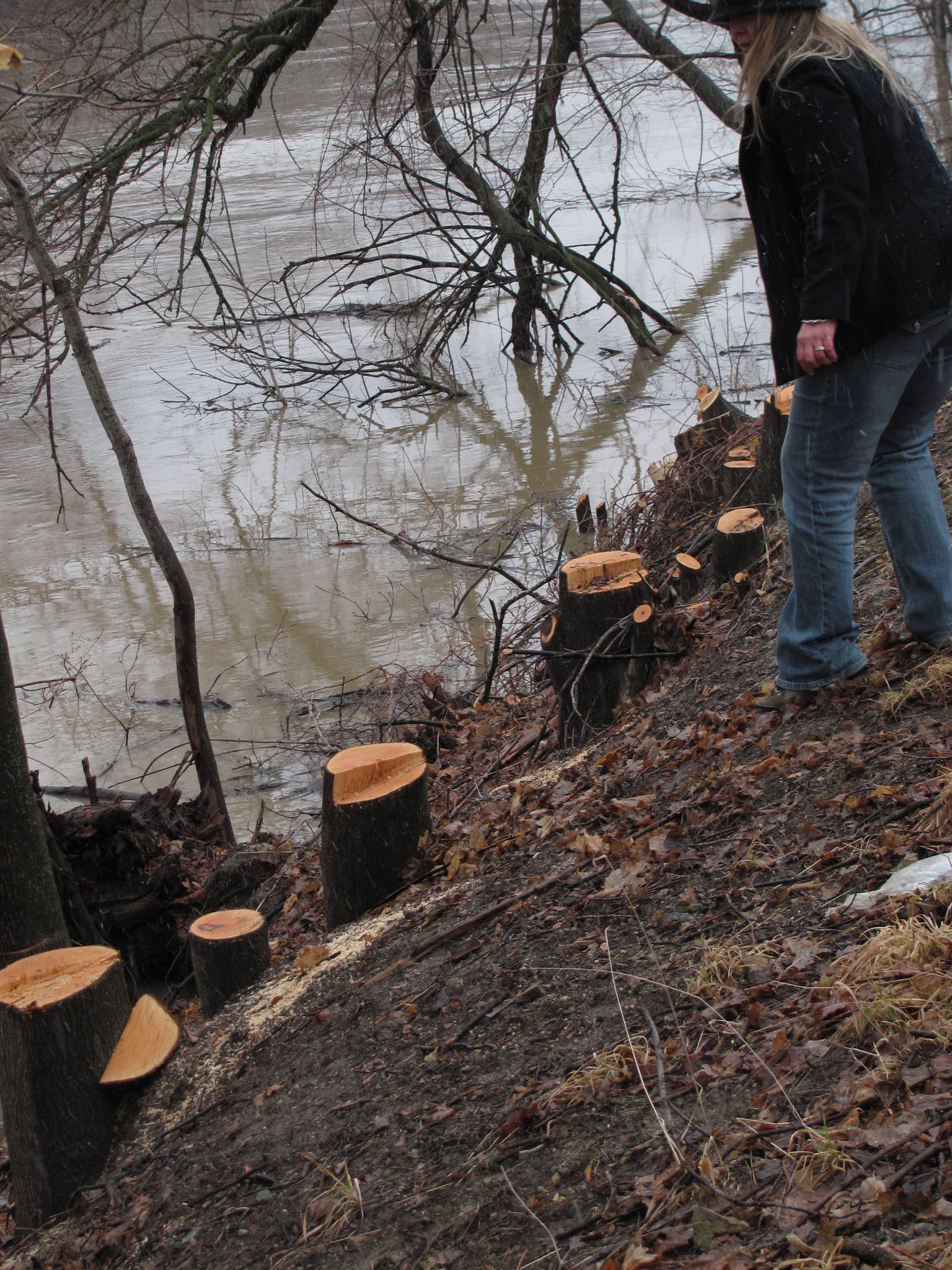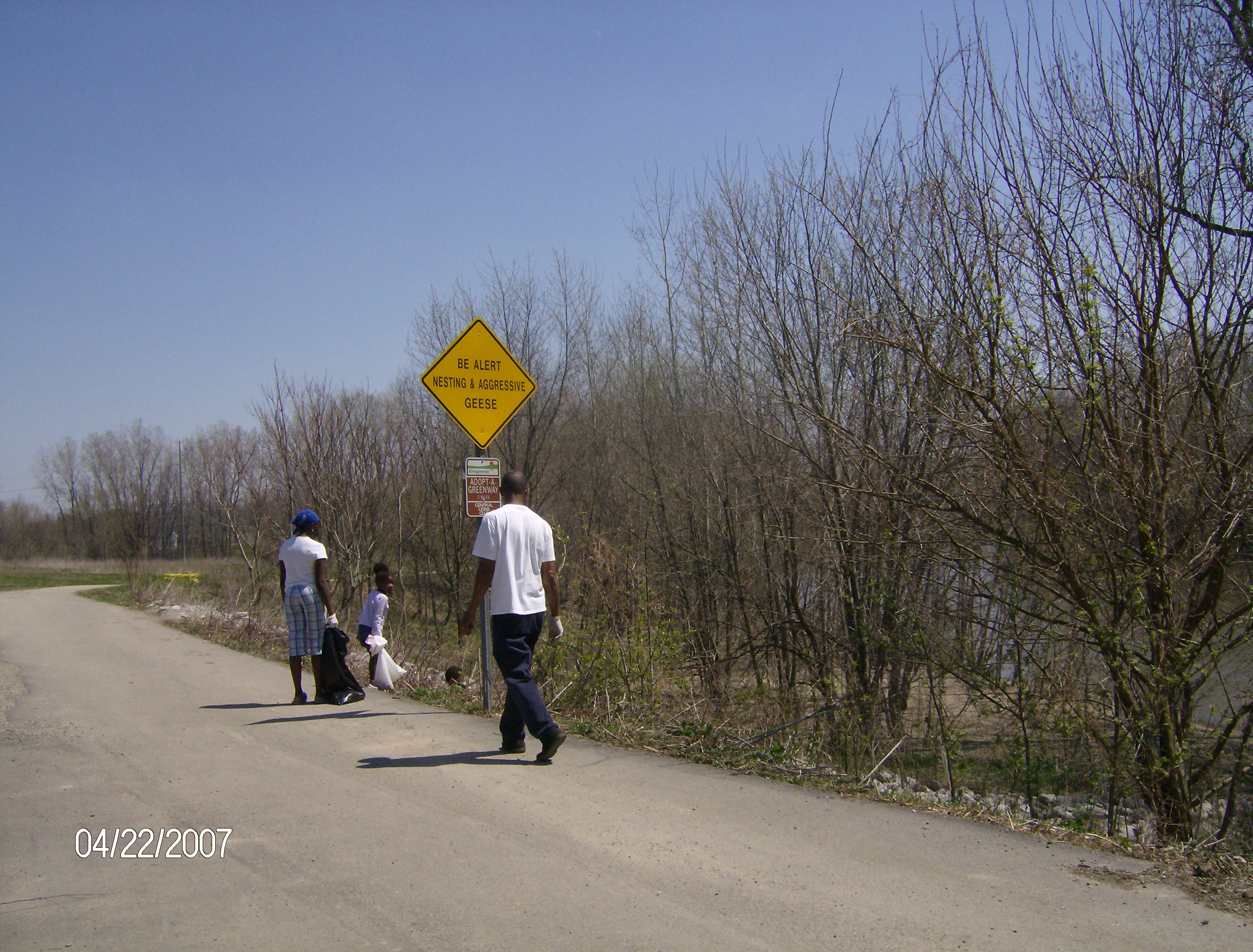VIDEO AND COVERAGE HERE:

Levee Tree Removal in Fort Wayne
It has recently come to the attention of Save Maumee that trees along the Maumee River and St. Mary’s River are indiscriminately being cut down by order of the Board of Public Works by orders of the US Army Corps of Engineers. Apparently, this area of the riverbank lies on a levee and during one of the last big floods in Fort Wayne, the riverbank and the trees fell into the water. The U.S. Army Corps of Engineers is in charge of regulating levees by setting the safety guidelines and according to city planners, the US ACE directed the city to remove the trees and make repairs or lose the acceptable rating of flood protection. This has resulted in the removal of hundreds of trees along the riverbanks of the Maumee River – in addition to trees removed from the St. Marys and St. Joe Rivers as well.
Straight from the Board Of Public Works
“Officials in Fort Wayne say there should be no trees cut down along the city’s flood levees because there aren’t any. The levees here were built by the corps in the 1990s, and the only trees near a levee are on the river side of the structure, where they slow the current and help stabilize the levee. ‘Every year, (Army Corps inspectors) walk every inch of those levees,’ said Bob Kennedy, city public works director. Kennedy said the tree prohibition was issued by the corps in 2007, so any trees that needed to be cut down would have already been spotted and removed.”
Fort Wayne Journal Gazette, 6/14/09.
Well Mr. Kennedy, you ARE cutting down trees, hundreds of them in the past 3 weeks. Save Maumee recognizes the importance of levee safety and does not dispute that the city needs to be able to assess and observe the levees and keep our homes safe from floods. We also recognize that the rivers are filthy; contaminated with E. coli, Mercury, PCBs, nutrients, phosphorous, sewage, garbage and general pollution – and we do not see the city working to correct or repair any of these issues; aside from a federal mandate to separate the sewer and storm drains, which should have been started 20 years ago. In the world of water, vegetation coexists along rivers. The vegetation holds soil in place when water rises and falls. Native plants with long taproots prevent soil from being washed downstream, filter water, attract diverse species of birds and insects, slow down and absorb water as it moves quickly through the banks during times of flooding and high water, while providing shade that increases Dissolved Oxygen in the water for wildlife. Removal of that vegetation increases soil erosion. Removal of vegetation is another reason streambanks to fall into the river.
Tree removal and stump grinding has been a hot discussion topic around town. Between Ash Trees being removed due to the Emerald Ash Borer invasion (equaling 24% of the tree canopy in Fort Wayne) and the Oak Trees being eaten by the Gypsy Moths; no tree is sacred from removal or damage. Now trees are being removed due to “potential levee disturbance.” According to a former employee of the Corps Engineer and Research Development, There has never been a documented problem with a tree. (MSNBC- Associated Press 6/9/2009) The literature on the presence of vegetation indicates that it may actually strengthen a levee,” said Andrew Levesque, senior engineer for King County Washington. Yet, the mowing down of trees in Fort Wayne, never seems to end. The city has no plans to replace the trees elsewhere, except in mowed city/county parks, and does not see a problem with tree removal. (Board of Public Works, April 2011)
Hurricanes breaking levees and the affects in Fort Wayne, IN?
Tree removal on levees has been an ongoing problem around the country since Hurricane Katrina blasted through New Orleans, destroying the levees built to protect the city. Recognizing that part of the issue in New Orleans, was the failing levee system, the US ACE has taken a fresh look at all of the levee systems in the U.S. They have compiled a list of blanket regulations that every city or county lying in a floodplain must follow. The US ACE tightened its regulations with specific criteria regarding structure safety and vegetation. But, they tightened their regulations claiming there is an understanding that levee systems commonly share the same space as water conveyance and critical ecosystems and habitats, and that working with these interests is vital in effectively managing flood risks. (Recommendations for a National Levee Safety Program; A Report to Congress from the National Committee on Levee Safety, 2009)
Yet Fort Wayne indiscriminately cuts trees out on entire riverbanks without planning to replace them anywhere – while our rivers get dirtier and turn into culverts.
What do citizens say?
Concerned citizens have contacted Save Maumee regarding the removal of these trees, filling in of flood plains (approving permits and failing to enforce fines), business vehicles leaking directly into storm drains, waste gates being open with water flushing out during times without rain, concern about removal of vegetation without plans to replant elsewhere along the river and the lack of city planning that coincides with increasing the water and ecological quality along the banks, along with other issues. In fact, we can be bold enough to say that our organization is working to correct more than a century of neglect, degradation, and abuse on the Maumee River in Fort Wayne and have yet to see others take an active approach to STOP pollution. We see the city cutting down trees, changing the structure of the rivers, and having a continued disregard for the communitys greatest natural assets – which also directly affects those downstream from us. And we (Save Maumee 100% volunteers) continue to pull tires, plastic, stoves, refrigerators, etc. out of the riverbanks while also planting the trees and vegetation that actually do some good. ALL of which has been DNR approved. The questions remain: 1) Who decides where these trees are removed? 2) Who is advising the board and the “experts” that have been consulted? 3) Who is footing the bill for this large scale project?

BEFORE AFTER
Army Corps issues tree chopping orders; Policy aimed at protecting levees draws fire from locals
The above article states that “Army Corps of Engineers are on a mission to chop down every tree in the county Columbia LA…but later settled on a few dozen.”
The corps eventually dropped the idea because of state wildlife officials complained that the policy would destroy habitat, and residents in Sacramento and elsewhere objected that it would turned the rivers into more than barren culverts. The corps eventually dropped the idea.
So why cut down every tree indiscriminately along the levees in Fort Wayne, IN?
Lawyers have sent a letter of inquiry into the massive tree removal along local riverbanks and we eagerly await the report. See it here: Request for Information
All this came about in the Army Corps of Engineers in 2006 due to Hurricane Katrina smashing the New Orleans levees in Aug. 2005 and now letters from ACE are making their way into local requirements. The Corps wants a way to protect levees, yet our riverbanks have nothing to do with a hurricane and the City of New Orleans being built below sea level and the levees bursting from the pressure of a violent ocean during a hurricane event. TREES had NOTHING to do with it!
One reason that city continues to have flooding issues may have to do with the land use. More than 85% of Indianas wetlands have been eliminated since the 1800s, and many forested wetlands have been lumbered for their high-value hardwood. More than five million acres of wetlands used to exist in the state, but just over 800,000 acres remain today. Our wetlands are nature’s kidneys and filtrate pollution as well. Water is more destructive than fire, if you keep it at bay in one part of a rip/rap levee area…it will find a way to meander somewhere else; that area may never have flooded before. Removing trees “may contribute to the erosion of the banks.” It definitely contributes to the fast rising and falling of water levels called flashiness. City planning remains to be poor, even though building previously on a floodplain was not this administrations mistake. The city/county continually ignores the importance of the ecological systems along the rivers, which also provides safety to the quality of the waterways, fish, birds, etc. Highlights of Plan-it Allen – Allen County’s Comprehensive Plan
An old wise man, spoke of an idiom. “Watch out for people who talk out of both sides of their mouth.” This means ~ To say different things to different people on the same subject, in order to appease the one with whom you speak. Save Maumee uses the old cliche’ to point out water issues…
Actions always speak louder than words.
April 1, 2011April 1, 2011
0 Comments
